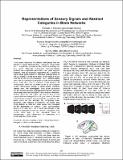| dc.contributor.author | Pinotsis, Dimitrios | |
| dc.contributor.author | Siegel, Markus | |
| dc.contributor.author | Miller, Earl K | |
| dc.date.accessioned | 2021-11-10T21:11:01Z | |
| dc.date.available | 2021-11-05T14:21:40Z | |
| dc.date.available | 2021-11-10T21:11:01Z | |
| dc.date.issued | 2019 | |
| dc.identifier.uri | https://hdl.handle.net/1721.1/137475.2 | |
| dc.description.abstract | Many recent advances in artificial intelligence (AI) are rooted in visual neuroscience. However, ideas from more complicated paradigms like decision-making are less used. Although automated decision-making systems are ubiquitous (driverless cars, pilot support systems, medical diagnosis algorithms etc.), achieving human-level performance in decision making tasks is still a challenge. At the same time, these tasks that are hard for AI are easy for humans. Thus, understanding human brain dynamics during these decision-making tasks and modeling them using deep neural networks could improve AI performance. Here we modelled some of the complex neural interactions during a sensorimotor decision making task. We investigated how brain dynamics flexibly represented and distinguished between sensory processing and categorization in two sensory domains: motion direction and color. We found that neural representations changed depending on context. We also trained deep recurrent neural networks to perform the same tasks as the animals. By comparing brain dynamics with network predictions, we found that computations in different brain areas also changed flexibly depending on context. Color computations appeared to rely more on sensory processing, while motion computations more on abstract categories. Overall, our results shed light to the biological basis of categorization and differences in selectivity and computations in different brain areas. | en_US |
| dc.description.sponsorship | NIMH (Grant R37MH087027) | en_US |
| dc.language.iso | en | |
| dc.publisher | Cognitive Computational Neuroscience | en_US |
| dc.relation.isversionof | 10.32470/ccn.2019.1290-0 | en_US |
| dc.rights | Creative Commons Attribution 3.0 unported license | en_US |
| dc.rights.uri | https://creativecommons.org/licenses/by/3.0/ | en_US |
| dc.source | Cognitive Computational Neuroscience | en_US |
| dc.title | Representations of Sensory Signals and Abstract Categories in Brain Networks | en_US |
| dc.type | Article | en_US |
| dc.identifier.citation | Pinotsis, Dimitris, Siegel, Markus and Miller, Earl. 2019. "Representations of Sensory Signals and Abstract Categories in Brain Networks." 2019 Conference on Cognitive Computational Neuroscience. | en_US |
| dc.contributor.department | Picower Institute for Learning and Memory | en_US |
| dc.contributor.department | Massachusetts Institute of Technology. Department of Brain and Cognitive Sciences | en_US |
| dc.relation.journal | 2019 Conference on Cognitive Computational Neuroscience | en_US |
| dc.eprint.version | Final published version | en_US |
| dc.type.uri | http://purl.org/eprint/type/JournalArticle | en_US |
| eprint.status | http://purl.org/eprint/status/PeerReviewed | en_US |
| dc.date.updated | 2021-03-25T18:26:08Z | |
| dspace.orderedauthors | Pinotsis, D; Siegel, M; Miller, E | en_US |
| dspace.date.submission | 2021-03-25T18:26:09Z | |
| mit.license | PUBLISHER_CC | |
| mit.metadata.status | Publication Information Needed | en_US |
